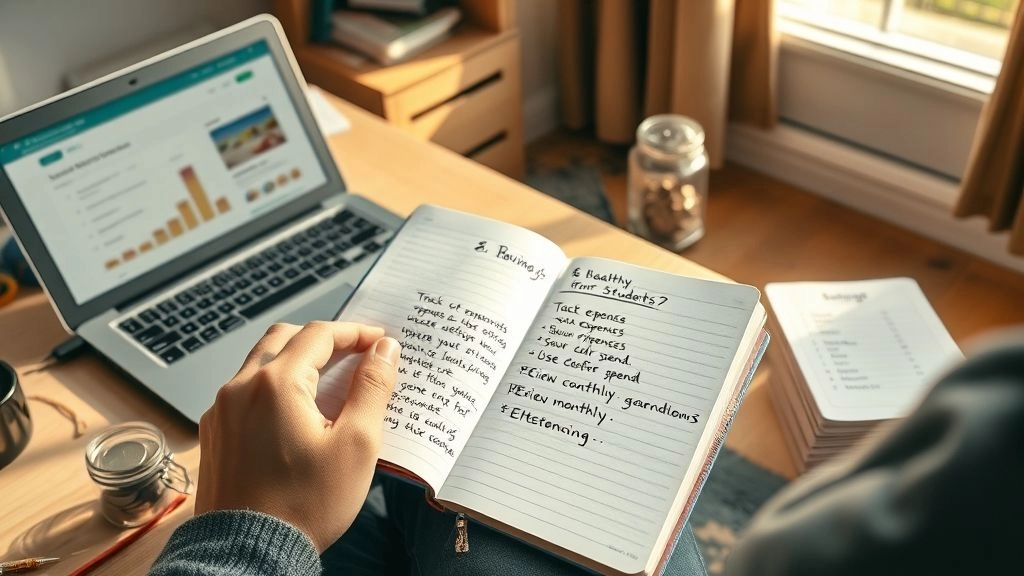That Sneaky Low-Balance Feeling
You know the moment. That gut-drop when you check your bank app and see next to nothing staring back at you. Maybe it’s after a late-night snack run with friends, or a quick online “just this once” purchase (they always feel justified at 1 a.m., huh?). I wish I could say I’ve only been there once, but honestly… it used to be the story of my student life.
But here’s the thing—those “how am I already broke again?” moments? They’re warning signs. Not giant, flashing sirens; more like that little notification you keep swiping away. And if you ignore them, the stress? It snowballs. So what if you could ditch that cycle and actually make your money work for you? That’s what healthy financial habits are all about. Not overnight perfection—just small, real changes that build up over time. Let’s get into it.
Why Care About Habits?
Can Tiny Tweaks Change Your Money Story?
First, let’s be honest. Most of us aren’t learning this stuff in class—and growing up, money talk at home was usually, “We can’t afford that.” Sound familiar? So we wing it, buying what we want, then scrambling later. But forming a few good habits now (emphasis on “now”—procrastination is a budget killer) can literally set you up for the rest of your life.
Plus, the habits you build in your student days? They stick. And if you need more reason to start, real-life students who save, budget, and review their spending report not only less money stress—but more freedom to say yes to things they love. If you don’t believe me, check out Financial habits of students for some solid proof (plus, tips straight from people figuring this out right now).
Take an Honest Money Snapshot
What’s Hiding in Your Account?
All right. Step one: know what’s coming in, what’s going out, and what’s just… leaking away. I avoided this forever because I was scared to face it. (Spoiler: not looking doesn’t make the overdraft fee go away.) Here’s how simple it gets:
| Category | Example Amount | Notes |
|---|---|---|
| Income (part-time job) | $400/month | Paychecks, tips |
| Expenses (rent, food, phone) | $320/month | Average—varies if you go out more |
| Debts (credit card) | $50/month | Try to pay more than the minimum |
Don’t overthink it. Write it down. Use your notes app, a spreadsheet, or the back of an envelope. Some of my friends swear by apps—others, like me, stick to scribbled lists. According to research on student money habits, most students who track their expenses feel more in control—shocking, I know.
Budgeting (Yep, Really)
How Do You Even Start?
Let’s talk “budget.” I know—I used to hear that word and picture spreadsheets, spreadsheets, spreadsheets. Boring. Except, when you break it down, a budget is just a plan for how you want your money to work for you. What if you budgeted in a little “fun money” every week, instead of feeling guilty every time you grab boba with friends or rent a movie for movie night?
One semester, I tried not budgeting. By week three, it was “Hello, credit card.” Next semester, I mapped out a super basic plan. Food: $40/week. Coffee: $10/week. Essentials: $30/week. “Random” (for the things that always pop up): $15/week. That was literally it. It felt like a weight off—like I could finally breathe, even when things were tight.
Want shortcuts? Download a free budgeting app like Mint, or even try the classic envelope system (yes, with literal envelopes—it worked for my housemate who hated tech). The point is: do what works for you. No one’s grading you here. Still skeptical? Give it one month. If you need more proof, the stories at Bad financial habits examples drive home just how rough things can get when you keep avoiding it.
Save Before You Spend
Could You Handle an Emergency Right Now?
Here’s a gut-check: if you got hit with a $100 expense today—phone breaks, urgent travel home, whatever—could you cover it? Or would you be texting your parents for a bailout? I’ve definitely been in that second camp. But one tiny habit changed everything: saving just $10–20/week from whatever came in, right when I got paid.
Automate it if you can. Set up a separate account, or even just a cash jar in your drawer. The goal isn’t to save a fortune overnight. It’s about building a cushion, so one little emergency doesn’t wreck your whole month. In fact, students who treat savings like a monthly bill survive “funny money months” (why do all textbooks get billed at once, anyway?) way better.
Fun fact: most Canadian undergrads in a 2025 survey said they had to scramble for unexpected bills—but the ones who’d put aside small amounts regularly felt way less stressed. If you want to be in the “stress less” camp, just start with a little bit each week. It adds up.
Savings Hack: The Jar System vs. Auto-Transfers
| Method | Pros | Cons |
|---|---|---|
| Jar system (cash) | Easy to see, good for visual types | Tempting to “borrow” cash back out |
| Auto-transfer | Set it, forget it, earns interest | Less visible: out of sight means easy to forget about—which might be a pro for some! |
The Power of Side Gigs
Getting Extra Without Burning Out
Working while in school? That’s a given for most of us—fast food, campus rec center, dog-walking, tutoring, you name it. Here’s the trick: picking a gig that fits your energy and schedule instead of draining you. When I started freelancing (hello, $25 for editing someone’s essay), I realized not only did extra cash go further, but I was less likely to panic when sudden costs hit.
Here’s a secret: students who keep work hours low and manageable often do better—financially and academically. If you’re curious, check out gig comparisons below.
| Gig Type | Pros | Cons | Potential |
|---|---|---|---|
| Campus Job | Flexible, low stress | Lower hourly pay | $14–16/hour |
| Driving or Delivery | Variable hours, tips | Can be exhausting | $18–25/hour |
| Online Freelance | Work from home, build skills | Inconsistent gigs | $10–50/hour |
Pick one or two, mix it up, but remember: time is as valuable as money (don’t let that part-time job eat into your finals crunch time).
Debt: Use It, Don’t Lose It
Is Credit Evil?
Ah, credit cards—the shiny plastic that promises a new backpack now and pays the bill later. I’ll be honest: I racked up debt early, convinced it was “no biggie” as long as I made the minimum payment. Big mistake. Those interest fees show up like uninvited party guests.
So here’s the golden rule: Use credit, don’t let it use you. If you get a card, start with the lowest limit possible. Only charge what you know you can pay off that month. Need a reason? Good credit habits now mean waaay less hassle when you want an apartment, car, or, eventually, anything grownup. Check out good financial habits for young adults for more real-world guidance—it’s pure gold.
Compare “good debt” (student loans or investments in your future) versus “bad debt” (buying stuff you don’t even remember a week later). One you can plan for; the other… yeah, avoid.
Penny-Tracking (Without the Headache)
Is It Worth Counting Lattes?
Here’s the thing: tracking every penny sounds overwhelming, but modern apps make it almost automatic. Mint will pull everything in for you; others, like GoodBudget, let you set spending “buckets.” Want old-school? Print out your statement, grab a highlighter, and see where the money’s going. (Entertainment and lifestyle gobble up the most for students, says research on student spending behavior.)
When you see how fast those $3-5 purchases add up, you’ll start choosing differently—promise.
Favorite Free Apps for Students
- Mint: Connects bank accounts and cards automatically. Categories your spending, free charts.
- PocketGuard: Tells you what’s “safe to spend” in real time.
- Manual tracking: Not fancy, but putting pen to paper is surprisingly powerful for accountability.
Whichever system you pick, use it for one month—it’ll change the way you see your spending (for real).
Investing: Start Sooner Than Later
Tiny Seeds, Big Future
What if you put $30 a month in a high-interest savings account or a student investment app? Sounds small, but the “magic of compounding” means the earlier you start, the less you have to catch up later. And if you don’t get it yet, don’t sweat—it took me a while too.
If your school has a finance club or holds seminars, check them out. Or just poke around 10 good money habits to get unstuck.
Why? Because if you build even scrappy investing or saving habits now, you’ll thank yourself post-grad—promise.
Review and Adjust Consistently
Is Your Budget Still Working?
Money habits aren’t set-and-forget. Stuff changes. Rent goes up, you move apartments, a new expense pops up. So, at least once a month, do a five-minute check-in:
- Did you stick to your budget, or are your takeout meals creeping up?
- Is your income the same, or did you land a new gig?
- Did that streaming subscription renew (again)?
If you keep slipping, don’t beat yourself up. Just… adjust. One of my best friends had to keep tweaking her “fun money” until it stopped blowing holes in her savings. (She started with $10/week, bumped it to $15 after realizing movie night was non-negotiable.) The best habits are flexible, not perfect.
Calling It Home: You’ve Got This
So there you have it—eight healthy financial habits examples for students and real stories from the trenches. If you’re skimming at this point (hey, no judgment), here’s the gist: pay attention to the warning signs (those “how did I spend that much?” moments), start small (one habit, one app, one month), and celebrate the tiny wins.
Nobody gets it right all the time. Money is weird, tricky, emotional—sometimes downright stressful. But little by little, with the right habits, it gets better. You might mess up. That does not make you “bad with money”—seriously, who nailed this from day one? The difference is picking yourself up and tweaking things, not giving up when credit card stress or bank account blues strike again. Avoid those bad financial habits examples (procrastinating, impulse buying, hiding from the truth) and lean into what works for you.
Here’s my nudge: Try tracking your spending for just one week. Or stash $10 into a savings jar—today. Or build your first monthly budget (messy is fine, trust me). Then, if you hit a snag? Come back, adjust, and keep going. You’ve got this. And if you need a little inspiration, go peep those financial habits of students. We’re all learning as we go.
What’s your first move? Drop your best (or worst) money habit below—let’s swap notes and battle those broke days together.













